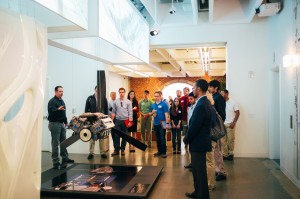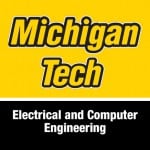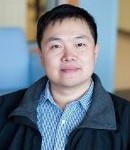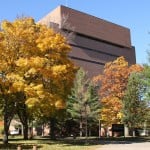Wayne Weaver (ECE) is the principal investigator on a project that has received a $119,997 research grant from the U.S. Department of Defense, Office of Naval Research. Rush Robinett (ME-EM) and Nina Mahmoudian (ME-EM) are Co-PI’s on the project entitled “Autonomous Microgrids: Theory, Control, Flexibility and Scalability.”
This is the first year of a potential four-year project that could total $869,980.
 I am writing today while en route back to Houghton after a week in the San Francisco Bay Area. I was participating in something that has become an annual Spring Break event, tagging along with 20 Michigan Tech students on a whirlwind tour we call the Silicon Valley Experience. Students from all different majors apply through an internal competition to take part. They visited 12 different companies over 4 days, learning all about the high-tech world of Silicon Valley and the entrepreneurial culture surrounding it. The list of companies includes household names – Apple, Google, Facebook – along with other established companies and new start-ups. There is a Michigan Tech connection at all these places, which helps to get our foot in the door. My time is split between visiting with Michigan Tech alumni, both old friends and new, and joining the students at company visits as my schedule allows. I want to give a shout-out here to our Director of Industry Program Development, Adam Johnson, for the terrific job he did at organizing the event and taking care of all the logistics.
I am writing today while en route back to Houghton after a week in the San Francisco Bay Area. I was participating in something that has become an annual Spring Break event, tagging along with 20 Michigan Tech students on a whirlwind tour we call the Silicon Valley Experience. Students from all different majors apply through an internal competition to take part. They visited 12 different companies over 4 days, learning all about the high-tech world of Silicon Valley and the entrepreneurial culture surrounding it. The list of companies includes household names – Apple, Google, Facebook – along with other established companies and new start-ups. There is a Michigan Tech connection at all these places, which helps to get our foot in the door. My time is split between visiting with Michigan Tech alumni, both old friends and new, and joining the students at company visits as my schedule allows. I want to give a shout-out here to our Director of Industry Program Development, Adam Johnson, for the terrific job he did at organizing the event and taking care of all the logistics.
After one of these trips to California I come away with so many impressions that I could easily fill two or three of these columns with my random thoughts. I just might.
First off, we all just have to admit that Silicon Valley is the center of the universe when it comes to innovation in the information technology space. There is no other place like it. It is brimming with all sorts of electrical engineers, computer engineers, software engineers, and entrepreneurs working to create the next big thing and disrupt last year’s technology, with the support of a massive economic engine of venture capital. Almost overnight, it seems, the technology created there has gone from a novelty to a necessity – search engines on Google, smart phones from Apple, social media on Facebook where these very words are being written. I can sit in an airport and be connected to family, friends, and work via a communication network called the Internet that hardly anyone imagined some 30-40 years ago. These are hugely powerful forces that have transformed our lives completely, and the pace of that change shows no signs of slowing down.
There is a lot of excitement and buzz surrounding these technological innovations, and as a result Silicon Valley attracts the best and brightest engineering talent. There are a lot of job opportunities, but even so the market can be pretty competitive as the top companies can afford to be pretty choosy. It’s like the song lyric about New York – if you can make it there, you can make it anywhere. In fact, the analogy with Broadway is pretty apt, as job interviews have been transformed from conversations across a desk to auditions of actual programming and engineering skill. I understand the process can be pretty grueling. However, if one has what it takes, the salaries and perks are unmatched in the engineering world.
One immediate impression that I come away with is how the workplace itself has changed over the past decade. Google was on the leading edge, but their style has been picked up by most of the other established companies and newcomers. On this trip it seemed to me that Facebook is raising the bar even further. Every day is casual day. I don’t even bother packing a tie when I travel to California anymore; I wore the same pair of jeans all this week and half the time I was overdressed. More remarkable is the level of amenities available to employees – free food and drink 24/7, all you can eat, game rooms, music rooms, barber shops, bicycle repair, even medical care. The days of residential dormitories on or near the corporate campuses are not far away. The whole idea is to keep engineers and programmers at work and happy for hours on end, and not give them any reason to stop being productive. I get to sample this workplace style every so often because of a Google-sponsored research project I am on right now. I have to wonder what it would be like all the time – I guess one gets used to it – but for the few days at a time that I see it, I feel like I am living high on the hog. For the companies, it is clear that the cost of these amenities is far outweighed by the value of a productive employee.
I will bring this to a close here, and follow up in the next few weeks with my thoughts on 1) the culture of entrepreneurship in the high-tech world, 2) what universities like Michigan Tech should be doing to help students prepare for success, and 3) what can other regions of U.S., like the upper Midwest, learn from Silicon Valley. No doubt I’ll be trolling the Internet on my smartphone and checking in with social media to get some good material.
– Dan
Daniel R. Fuhrmann, Dave House Professor and Chair
Department of Electrical and Computer Engineering
Michigan Technological Univerrsity

Michigan Technological University’s Department of Electrical and Computer Engineering (ECE), along with Departments Biomedical Engineering (BME) and Physics were well represented at the annual SPIE Photonics West conference held in San Francisco, CA, on February 13-18, 2016.
Arash Hosseinzadeh, PhD candidate in electrical engineering, Derek Burrell, BSEE senior and SPIE/OSA MTU chapter president, and Mitch Kirby, BSBE (EE minor) presented papers and research findings on topics: Design and optimization of polymer ring resonator modulators for analog microwave photonic applications, Comparison of self-written waveguide techniques and bulk index matching for low-loss polymer waveguide interconnects, and Effects of incident intensity on laser speckle contrast imaging.
BME Chair Sean Kirkpatrick was session chair and moderator and ECE Prof. Chris Middlebrook co-authored two papers presented. Also attended were Nima Taherkhani, MSEE candidate, and ECE alumna Liz (Cloos) Dreyer ’12, currently a PhD pre-candidate in electrical engineering (optics) at the University of Michigan, Abhinav Madhavachandran, MSBE candidate, and Anindya Majumdar, PhD candidate Physics.
Student travel was partially funded by Michigan Tech’s Undergraduate Student Government (USG) and Graduate Student Government (GSG).
See more information on the SPIE/OSA MTU Chapter see mtu.osahost.org.
 I am writing today from beautiful Boulder, Colorado, where I have been attending a research progress review on a project I have been working on, along with other Michigan Tech faculty and students. The project is sponsored by Google. Michigan Tech is fortunate to be a research partner with Google on something they call a Multi-University Research Agreement, or MURA. I can’t tell you the technical details of what we are doing, yet, but later this year everything will be made public.
I am writing today from beautiful Boulder, Colorado, where I have been attending a research progress review on a project I have been working on, along with other Michigan Tech faculty and students. The project is sponsored by Google. Michigan Tech is fortunate to be a research partner with Google on something they call a Multi-University Research Agreement, or MURA. I can’t tell you the technical details of what we are doing, yet, but later this year everything will be made public.
Having observed how this project is managed over the past year, I am struck by how much the workplace, the team organizations, and the expectations of engineers have changed over the years. This has been a great experience for me, not only because the work is interesting but because it gives me a glimpse of what our graduates can expect as they enter the workforce.
One of the most remarkable things I have noticed is how collaboration tools have made the world a smaller place, and have made geographical differences practically irrelevant. The team working on this project, about 30 people all together, comprises full-time Google employees, independent contractors, engineering companies, and university teams like ours from Michigan Tech. The group is spread out from Hawaii, to California, to Michigan, and to Europe. Subsets of the team meet regularly via Google Hangout, which is a pretty easy-to-use teleconferencing tool, and it is like being in the same room (there is the one remaining issue of time zones, but most people don’t have a big problem with it.) Even when most of the group gets together in the same city, like this week, there are still those who call in and contribute.
The success or failure of this project (and I’m pretty sure it’s going to be successful) depends on the ability of all the participants to work together as a team. This week we had discussions about how things went in 2015, and the overall consensus was that the teamwork was pretty good. It reminds me of why it is so important for us at Michigan Tech to teach our students about teamwork in our capstone projects, whether in Senior Design or Enterprise. They are going to be working on teams when they leave the university, and knowing how to collaborate, how to get along, how to get work done on time, how to communicate, how to make expectations clear for others – these are all things that are going to be critical skills for career success. The other side of teamwork that we stress at Michigan Tech is the development of individual skills. Everyone on this Google project has a seat at the table because they are really good at what they do, and I don’t imagine that’s going to be any different anywhere else.
Finally, I will mention that the nature of engineering careers is changing rapidly. Certainly there will be those that work full-time for a large corporation, and maybe they stay with that corporation a long time. On the other hand, there are those that work for corporations, but change jobs often. Others work as independent contractors, coming and going from teams as their skills are needed. I am fascinated by these engineers, at least the ones I have seen in this group: they are extraordinarily talented in their particular area of expertise, and because of all the collaboration tools available today they can live wherever they want. In all of these cases I am just talking about engineers selling their time and expertise; I haven’t begun to talk about entrepreneurship, which is another avenue that engineers are increasingly exploring. The bottom line is, if an engineer is good at what he or she does, their career arc and their lifestyle is limited only by the imagination.
At Michigan Tech we do our best to prepare students for this new engineering environment of the 21st century. I am always open to feedback about how well we are doing.
Being able to travel to meetings like this has its perks. On Friday, when this is posted, I’ll be taking a vacation day and skiing at Loveland Pass, in the Rocky Mountains not too far Denver. Finally, I have a chance to see if all my time spent on Mont Ripley has done me any good!
– Dan
Dan Fuhrmann, Dave House Professor and Chair
Department of Electrical and Computer Engineering
Michigan Technological University
 The Department of Electrical and Computer Engineering (ECE) is now on Facebook and Twitter. Like and follow us for faculty spotlights, student accomplishments, outreach and events, industry and alumni news, and more; including a weekly post from the chair in “Fridays with Fuhrmann”. We hope you’ll add us to your social media picks.
The Department of Electrical and Computer Engineering (ECE) is now on Facebook and Twitter. Like and follow us for faculty spotlights, student accomplishments, outreach and events, industry and alumni news, and more; including a weekly post from the chair in “Fridays with Fuhrmann”. We hope you’ll add us to your social media picks.

We are happy to share with you our newly released ECE Annual Report 2015. A look back at our past year highlights research activities by Profs. Zhaohui Wang, Wayne Weaver, Bruce Mork, and Mike Roggemann, along with ECE’s involvement in Michigan Tech’s new research agreement with Google ATAP. Once again the year included a wide variety of hands-on student projects in our Senior Design and Enterprise programs and we thank our sponsors for making it all possible! Our undergraduate programs added two new concentrations starting Fall 2015 – Biomedical Applications and Environmental Applications within the Bachelor of Science in Electrical Engineering. We invite you to read about these stories and more. From all of us at ECE, best wishes for 2016!

Zhaohui Wang, Assistant Professor in the Department of Electrical and Computer Engineering at Michigan Tech University, received the Outstanding Service Award for her work as Information Systems Chair in the 10th ACM International Conference on Underwater Networks & Systems (WUWNet), held in Washington DC, October 22-24, 2015. The scope of the WUWNet conference covers a broad range of research directions relevant to underwater networks and network-related signal processing, communications, systems, and applications. The goal of WUWNet is to bring together researchers and practitioners in areas relevant to underwater networks, and serve as a forum for presenting state of the art research, exchanging ideas and experiences, and facilitating interaction and collaboration.
Tim Havens (ECE) co-authored two articles, “Data-informed Fuzzy Measures for Fuzzy Integration of Intervals and Fuzzy Numbers” and “Quadratic Program-based Modularity Maximization for Fuzzy Community Detection in Social Networks,” in the latest issue of IEEE Transactions on Fuzzy Systems. The second article was written with former graduate student, Jianhai Su, who is now at McAfee.
Wayne Weaver (ECE) has received $97,460 from Sandia National Labs under contract for a research and development project titled, “Unstable and Pulse Load Control Designs for Naval Electrical Systems.”
Laura Brown (CS/AIM) is the principal investigator on the research and development project, “Collaborative Research: CRISP Type 2: Revolution through Evolution: A Controls Approach to Improve How Society Interacts with Electricity” that has received a $699,796 grant from the National Science Foundation. Also working on the project are co-pi’s Chee WooiTen (ECE) and Wayne Weaver (ECE). This is a three-year project.
Durdu Guney (ECE) has received a $131,305 grant from the U.S. Department of Defense, Office of Naval Research for the research and development project titled, “Full Compensation and Control of Losses in Metamaterial Devices without Gain Medium.” This is the first year of a three-year project, totaling $374,027.
Joshua Pearce (MSE/ECE) published an article “Overcoming the North’s Diesel Dependence With Renewable Energy” in Circle, the magazine of the World Wildlife Federation’s Global Arctic Program and was posted on their arctic blog, Thin Ice Blog. Joshua Pearce’s (MSE/ECE) research showing a high ROI for open source scientific hardware development was the top story on NSF’s Science 360. It was also covered by others including ECN Magazine and 3Ders.
Graduate students Tony Pinar (ECE) and Bas Wijnen (MSE) collaborated with Jerry Anzalone (MSE), Tim Havens(ECE), Paul Sanders (MSE) and Joshua. Pearce (MSE) on a paper titled: Low-cost Open-Source Voltage and Current Monitor for Gas Metal Arc Weld 3-D Printing published in the Journal of Sensors.
Graduate students Wyatt Adams (ECE), Ankit Vora (ECE) and Jephias Gwamuri (MSE) co-authored a paper with Joshua Pearce (MSE/ECE) and Durdu Guney (ECE). Controlling optical absorption in metamaterial absorbers for plasmonic solar cells, for the SPIE Proceedings on Active Photonic Materials. Graduate student Bas Wijnen (MSE) co-authored a paper with Jerry Anzalone (MSE) and Joshua Pearce (MSE/ECE) on Multi-material additive and subtractive prosumer digital fabrication with a free and open-source convertible delta RepRap 3-D printer published in the Rapid Prototyping Journal.
 The Association for Computing Machinery (ACM), the world ‘s largest educational and scientific computing society, has named Associate Professor Shiyan Hu (ECE) as an ACM Distinguished Speaker.
The Association for Computing Machinery (ACM), the world ‘s largest educational and scientific computing society, has named Associate Professor Shiyan Hu (ECE) as an ACM Distinguished Speaker.
ACM’s Distinguished Speaker Program identifies top computing technology leaders and innovators, and makes them available to speak at colleges and universities, corporations, events and conferences and ACM local chapters.
Each distinguished speaker serves a three-year term. Hu will be available to speak about computer aided design for VLSI circuits and cyber-physical systems.
Hu received a prestigious National Science Foundation (NSF) CAREER Award. He is a senior member of the Institute of Electrical and Electronics Engineers (IEEE) and has chaired more than 70 committees for IEEE conferences.
Hu’s ultra-fast slew buffering technique has been widely deployed in industry. For example, it became a default option in the IBM physical design flow used for designing more than fifty microprocessors and ASIC chips, including IBM flagship chips POWER 7 and 8.
